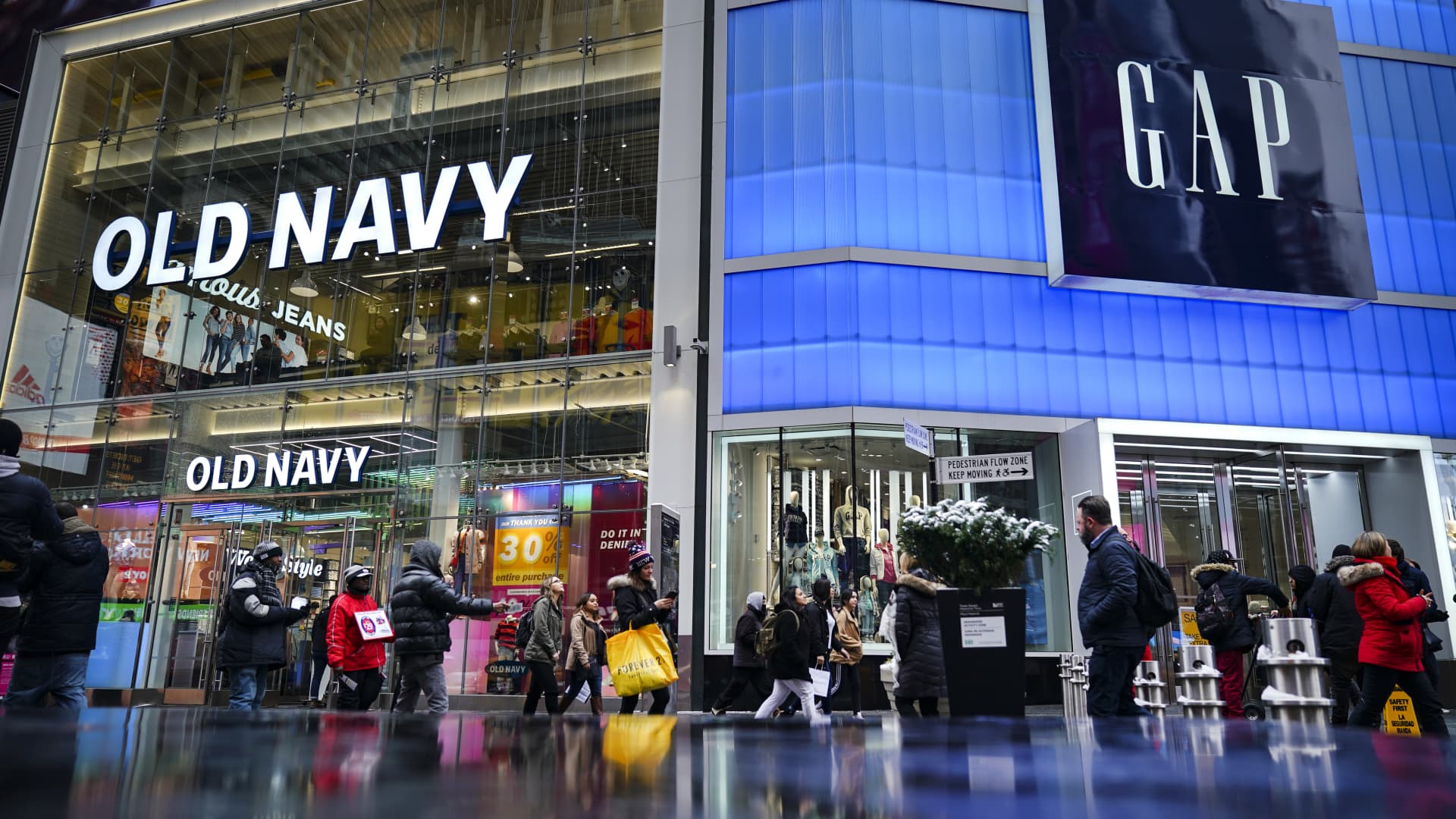
Gap reported mixed results on Thursday and underwhelming current-quarter guidance as the longtime mall retailer warned of an “uncertain consumer” and posted another quarter of declining sales across all four of its brands.
The company is projecting net sales to decrease in the low double-digit range for the fiscal third quarter compared to last year’s net sales of $4.04 billion. Analysts had expected third-quarter sales to be down 6.8%, according to estimates compiled by Refinitiv.
For the three-month period that ended July 29, Gap beat Wall Street’s estimates on the bottom line but fell short on the top.
Here’s how the apparel retailer did in its fiscal second quarter compared with what Wall Street was anticipating, based on a survey of analysts by Refinitiv:
- Earnings per share: 34 cents, adjusted vs. 9 cents expected
- Revenue: $3.55 billion vs. $3.57 billion expected
The company’s reported net income for the quarter was $117 million, or 32 cents per share, compared with a loss of $49 million, or 13 cents per share, a year earlier. Excluding one-time restructuring costs, Gap reported a net income of 34 cents per share.
Sales dropped 8% to to $3.55 billion, compared with $3.86 billion a year earlier.
Same store sales at the company were down 6% during the quarter, while analysts had expected comparable sales to be down 4.4%, according to StreetAccount.
Gross margins, which have been expanding over the last two quarters, were up 3.1 percentage points to 37.6% thanks to lower air freight expenses and a slowdown in discounting, Gap said. It expects gross margins to continue to grow throughout the fiscal year.
Halfway into Gap’s fiscal year, the retailer is expecting full-year sales to drop in the mid-single digit range compared to last year, which is in line with what analysts had expected, according to Refinitv.
The report comes two days into Richard Dickson’s tenure as Gap’s new CEO. The former Mattel executive, who started in the new role on Tuesday, is a branding expert who oversaw Mattel’s Barbie franchise. Gap is betting Dickson can breathe new life into Gap’s brands: its namesake banner, Old Navy, Banana Republic and Athleta.
All four of the brands, which have vastly different assortments and customer bases, have seen quarter after quarter of sagging sales and that trend has continued.
Here’s a closer look at how they did during the fiscal second quarter:
Old Navy: The affordable apparel retailer and Gap’s biggest revenue driver saw sales and comparable sales both down 6% at $1.96 billion. Its target customer, the lower-income consumer, shopped less during the quarter and sales were slow in its active category. The brand did see bright spots in women’s tops, woven bottoms and upticks in men’s and kids.
Gap: Gap’s eponymous banner saw sales down 14% at $755 million compared to the year-ago period. The brand has been under pressure from the shutdown of Yeezy Gap and the sale of Gap China. Sales were strong in its women’s category but were offset by store closures in North America. Comparable sales were down 1%.
Banana Republic: Sales were down 11% at $480 million compared to last year while comparable sales were down 8%. The brand is lapping outsized growth from past quarters when it saw a pull forward in demand from shoppers who suddenly needed clothes for work and going out again after the Covid pandemic came to an end.
Athleta: The athletic apparel brand saw sales of $341 million. While revenue was only down 1% compared to the year-ago period, comparable sales were down 7%. For a third quarter in a row, Gap missed the mark on what Athleta customers were looking for as the brand continues to grapple with finding the right product assortment.
“We’re seeing encouraging signs of progress, as our teams streamline the way we work so we can focus on growth-driving initiatives – a virtuous cycle that we’ll look to become our norm,” Dickson said in a news release. “This means we have to do things differently, with a clear focus on redefining our brands’ meaning to consumers, focusing on creativity, designing for relevance as a pursuit rather than a goal, and leveraging our remarkable legacy to shape an exciting new future.”
Gap’s chairman Bob Martin, who served as interim CEO for more than a year prior to Dickson’s appointment, had been working to restructure the business and streamline its management organization so the new chief executive would be able to hit the ground running as soon as he arrived.
Over the last year, Gap has cut more than 2,000 employees, or about 25% of its corporate roles, which has increased the number of direct reports for each manager from two to four and reduced management layers from 12 to eight, the company said previously.
The cuts were designed to remove layers of red tape and bureaucracy to make Gap more nimble in its decision-making and focused on its creative efforts, the company said previously.
The layoffs are saving Gap about $300 million, the first half of which will come in fiscal 2023. During its last quarter ended April 29, Gap’s margins shot up 5.6 percentage points year over year to 37.1%, sending its stock surging in aftermarket trading despite another quarter of declining sales.
